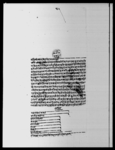A rukkā directing residents of Ālampura and Pakarbāsa to repair an irrigation channel (VS 1894)
ID: DNA_0013_0060
Edited and
translated by Manik Bajracharya
Created: 2019-05-14;
Last modified: 2019-12-03
For the metadata of the document, click here
The accompanying edition, translation/synopsis and/or commentary are available under the terms of the Creative Commons Attribution-ShareAlike 4.0 International License
Abstract
This royal order issued to the residents of Ālampura and Pakarabāsa along with the officers there directs them to repair an irrigation channel in Māḍi Besī. In return, the residents are exempted from half of the jhārā levy for the year.Diplomatic edition
[1r]
श्रीः\[royal seal]1स्वस्तिश्रीमन्महाराजाधिराजकस्यरुक्का¯¯ ¯¯ ¯¯ ¯¯ ¯¯2आगे•आलम्पूर•पकरवासकातपसिलवमोजीम्गाउगाउकाद्वार्याथरिमुषि
3यामिझार्यारैतिगैह्रचारवर्नछत्तिसैजातप्रति•पकरवासमाडिव्येसिकाषेतको
4कुलोभटौलिषोलालेअलागगरिलगिराषेछयोसालकुलोनवनायाकंपुपल्टं
5काषेतवाझारहनलाग्याभनिपकरवासकाद्वार्याथरिभलाआदमिलेहाम्राहजुर
6माविंतिगर्नआउदाजाहेरभयो९४सालकाझाराकारुपैयाआधिमाफगरिहुला
7किव्राह्मणर•तिलंगाघरवाहेक्तपसिलमाफिक्कागांउलेरषेतकमाउन्यामो
8हिगैह्रलेघरहिडप्कोझाराभैतिनमैन्हाकोषान्यासामल•रकोदालावंचरागल्कुंदा
9घन्टागासमेत्लि•पकरवासकाद्वार्यार•थरिसिवनारान्प्रसाञीमेहरसिंक
10र्कि•रामनाथपाध्यापौड्याल्कासिनाथपाध्याढुंग्याल्हरूसगसामेलभैफागु
11नचैत•वैसाषभरमानञाँकुलोषनिपहरोकाटिवनाईपानिचर्हाउन्याकामग
12र•हरहेमायेत्गरिझारामासामेलनभैकुलोनसिध्याईषेतवाझारहनगयाभ
13न्याकंपुपल्टंकोवालिवुझाउनुपर्लाडंडपनीपर्ला•औ•कुलोषन्दापहरोका
14ट्नालाईआलंपुरकाआग्रिजना१०लाईआलंपुरकाद्वार्यामुषियालेषटाई
15पठाईदिनुपहरोकाट्न्याआग्रिजना१०लाईरोजीन्नासिधार•ज्याला•पुजाला
16गन्याषर्च•पकरवासकोथुनुवाषेतकावालिमध्येषर्चलाउनुमोजरावक्सौला•
17तपसिल्
[table1]
| पकरवासभरअम्वल¯¯¯¯¯¯¯¯¯¯¯¯¯¯¯¯¯¯¯ | १ | ||
| आलंपुरमध्येगाउ¯¯¯¯¯¯¯¯¯¯¯¯¯¯¯¯¯¯¯ | ६ | ||
| कुवापानिफुलपा¯¯¯¯¯¯¯¯¯¯¯¯¯¯¯¯¯¯¯ | १ | ||
| माकाडम्¯¯¯¯¯¯¯¯¯¯¯¯¯¯¯¯¯¯¯ | १ | ||
| वांग्यासल्ला¯¯¯¯¯¯¯¯¯¯¯¯¯¯¯¯¯¯¯ | १ | ||
| गागल्¯¯¯¯¯¯¯¯¯¯¯¯¯¯¯¯¯¯¯ | १ | ||
| पिंषोरि¯¯¯¯¯¯¯¯¯¯¯¯¯¯¯¯¯¯¯ | १ | ||
| मेगर्पाभदौर्या¯¯¯¯¯¯¯¯¯¯¯¯¯¯¯¯¯¯¯ | १ | ||
26इतिसम्वत्१८९४सालमितिफागुनसुदि३रोज३शुभम्¯¯¯ ¯¯¯ ¯¯¯ ¯¯¯
Translation
[1r]
A rukkā of the glorious great king.
Āge: to all the four varṇas and thirty-six jātas including dvāryās, tharis, mukhiyās, mijhāryās and ryots of the villages of Ālampura1 and Pakarabāsa2 listed [below].
The dvāryās, tharis and local notables of Pakarabāsa came to petition us and apprised us [of the following,] saying: "The irrigation-channel in the paddy fields of Māḍi Besi has overflowed and been swept away by the Bhaṭauli River. If the irrigation channel is not repaired this year, the fields belonging to the kampu palṭana3 may remain barren." Half of the amount of jhārā [levy] of the year [VS 18]94 will be cancelled [for the labourers]. Excluding hulākīs, Brahmins and soldiers (tilaṃgā), each household of villagers or of tenants (mohī) who till land shall become compulsory labourers by command (dapko jhārā). Take with you provisions for three months, mattocks (kodālo), axes, crowbars (gal), mallets (kundā), sledgehammers and measuring rods (ṭā̃go). Gathering together with the dvāryās and tharis [named] Śivanārān Prasāĩ, Mehara Siṃ Kārki, Rāmanātha Pādhyā Pauḍyāl and Kāśīnātha Pādhyā Ḍhuṅgyāla, make a new irrigation channel by digging and cutting through rocks throughout [the months of] Phāguna, Caitra and Vaiśākha, and accomplish the task of geting water to flow4 [through it]. If, having been shown preferential treatment (harahemāyat), you do not join in the compulsory labour or leave the irrigation channel incomplete, so that the fields remain barren, you will have to compensate the crops for the kampu palṭana's [loss of] crops. A fine will also be imposed. During the digging of the irrigation channel, the dvāryās and mukhiyās of Ālampura shall dispatch 10 masons (āgri) for cutting rocks. The expenses for the daily raw food (rojinnā sidhā), wages and rituals for the 10 āgri shall be met from the standing crops of Pakarabāsa's thunuvā kheta5 . Deductions will be granted.6
Particulars
[table]
| Pakarabāsa ambala | 1 | ||
| Villages within Ālampura | 6 | ||
| Kuvāpāni Phulapā7 | 1 | ||
| Mākāḍam8 | 1 | ||
| Bāṅgyā Sallā9 | 1 | ||
| Gāgal10 | 1 | ||
| Piṃkhori | 1 | ||
| Megarpā Bhadauryā | 1 | ||
Tuesday, the 3rd of the bright fortnight of Phāguna in the [Vikrama era] year 1894 (1838 CE).
Commentary
This royal order directs the residents of Pakarabāsa and six villages within Ālampura, both lying in Rāmechāpa district, to participate in the repair of an irrigation channel as a civil duty. The paddy field to be irrigated belonged to the army. The document exempts households of Brahmins, soldiers and hulākī porters from the labour. The rest of the residents had to contribute their labour under unfavourable terms: they are ordered not just to work for free for three months on the channel, but also to bring their own supplies and tools. Interestingly, the document mentions providing wages to ten stonemasons, probably because it was an exceptionally difficult task to cut through rocks while digging the conduit.
The document exempts the residents from half of the amount of jhārā fee for the year. This implies that the residents of the stated villages had to pay an annual jhārā levy in cash. It is, however, unclear whether this levy was meant to substitute for regular jhārā obligations. M. C. Regmi argues that such an obligation could not be avoided through monetary compensation, and that a special levy in cash in lieu of the obligation was only rarely possible, in cases where the labourers were in a remote location or the area was sparsely populated (cf. M. C. Regmi 1971: 115-16).

